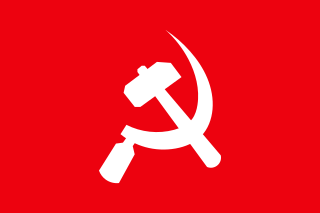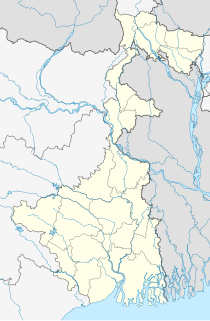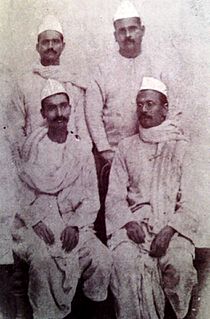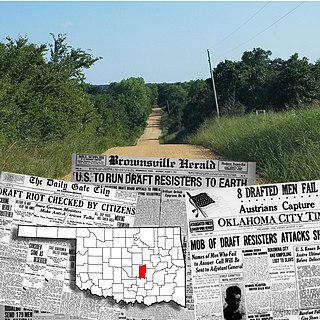
A tenant farmer is one who resides on land owned by a landlord. Tenant farming is an agricultural production system in which landowners contribute their land and often a measure of operating capital and management, while tenant farmers contribute their labor along with at times varying amounts of capital and management. Depending on the contract, tenants can make payments to the owner either of a fixed portion of the product, in cash or in a combination. The rights the tenant has over the land, the form, and measures of payment varies across systems. In some systems, the tenant could be evicted at whim ; in others, the landowner and tenant sign a contract for a fixed number of years. In most developed countries today, at least some restrictions are placed on the rights of landlords to evict tenants under normal circumstances.

The Communist Party of Nepal (Marxist–Leninist) was a political party in Nepal. It was launched in 1978 by the All Nepal Communist Revolutionary Coordination Committee (Marxist–Leninist), which founded by groups involved in the Jhapa movement. The CPN (ML) published Varg-Sangarsh and Mukti Morcha.

Naxalbari is a village in the Naxalbari CD block in the Siliguri subdivision of the Darjeeling district in the state of West Bengal, India. Naxalbari is famous for being the site of a 1967 revolt that would eventually lead to the Naxalite–Maoist insurgency.

The Champaran Satyagraha of 1917 was the first satyagraha movement led by Mahatma Gandhi in British India and is considered a historically important rebellion in the Indian independence movement. It was a farmer's uprising that took place in Champaran district of Bihar in the Indian subcontinent, during the British colonial period. The farmers were protesting against having to grow indigo with barely any payment for it.
Chandra Prakash Mainali more commonly known as C. P. Mainali is a communist politician in Nepal and former Deputy Prime Minister of Nepal.

The Green Corn Rebellion was an armed uprising that took place in rural Oklahoma on August 2 and 3, 1917. The uprising was a reaction by European-Americans, tenant farmers, Seminoles, Muscogee Creeks, and African-Americans to an attempt to enforce the Selective Draft Act of 1917. The name "Green Corn Rebellion" was a reference to the purported plans of the rebels to march across the country and to eat "green corn" on the way for sustenance.

Prithvinagar or Prithvinagar is a village development committee in Jhapa District in the Province No. 1 of south-eastern Nepal. At the time of the 1991 Nepal census it had a population of 15,612 people living in 2799 individual households.

The Naxalite–Maoist insurgency, officially referred to as the Left Wing Extremism (LWE), is an ongoing conflict between Maoist groups known as Naxalites or Naxals; a group of far-left radical communists, supportive of Maoist political sentiment and ideology, and the Indian government. The influence zone of LWE is called the Red corridor, which has been steadily declining in terms of geographical coverage and number of violent incidents, and in 2021 it was confined to the 25 "most affected" locations and 70 "total affected" districts across 10 states in two coal rich, remote, forested hilly clusters in and around the Dandakaranya-Chhattisgarh-Odisha region and the tri-junction area of Jharkhand-Bihar and-West Bengal. The Naxalites have frequently targeted tribal, police and government workers in what they say is a fight for improved land rights and more jobs for neglected agricultural laborer and the poor.
The Comprehensive Agrarian Reform Program, more commonly known as CARP, is an agrarian reform law of the Philippines whose legal basis is the Republic Act No. 6657, otherwise known as the Comprehensive Agrarian Reform Law (CARL). It is the redistribution of private and public agricultural lands to help the beneficiaries survive as small independent farmers, regardless of the “tenurial” arrangement. Its goals are to provide landowners equality in terms of income and opportunities, empower land owner beneficiaries to have equitable land ownership, enhance agricultural production and productivity, provide employment to more agricultural workers, and put an end to conflicts regarding land ownership.

Jangal Santhal, also known as Jangal Santal from Hatighisa village, Darjeeling district in north West Bengal, was one of the founders of the Naxalite movement.

The Herat uprising, locally known as the Uprising of 24th Hūt was an insurrection that took place in and around the city of Herat in western Afghanistan, across several days in March 1979. It included both a popular uprising and a mutiny of Afghan Army troops against the Democratic Republic of Afghanistan (DRA). The communist regime at first appealed to its Soviet allies for help, but the Soviet leadership declined to intervene. After the insurgents seized and held the city for about a week, the regime was able to retake it with its own forces, and the subsequent aerial bombardment and recapture of Herat left 3,000 to 25,000 of its inhabitants dead. It was the worst outbreak of armed violence in the country in 50 years, and was the deadliest incident in the 1978-1979 period following the Saur Revolution and before the start of the Soviet occupation.

Khadga Prasad Sharma Oli was a Nepalese politician and former Prime Minister of Nepal. He served three terms as prime minister from 11 October 2015 to 3 August 2016, from 15 February 2018 to 13 May 2021 as the first elected prime minister under the new constitution, and from 13 May 2021 to 13 July 2021.

Like slavery, serfdom has a long history that dates to ancient times.
Land reform in the Philippines has long been a contentious issue rooted in the Philippines's Spanish Colonial Period. Some efforts began during the American Colonial Period with renewed efforts during the Commonwealth, following independence, during Martial Law and especially following the People Power Revolution in 1986. The current law, the Comprehensive Agrarian Reform Program, was passed following the revolution and recently extended until 2014.
Naxalbari uprising was an armed peasant revolt in 1967 in the Naxalbari block of the Siliguri subdivision in Darjeeling district, West Bengal, India. It was mainly led by tribals and the radical communist leaders of Bengal and further developed into Communist Party of India (Marxist–Leninist) in 1969. The event became an inspiration to the naxalite movement which rapidly spread from West Bengal to other states of India creating division within the Communist Party of India (Marxist) party.
Julio López Chávez led a peasant rebellion in the late 1860s. He was a follower of Greek proto-anarchist Plotino Rhodakanaty, who moved to Mexico to organize peasants. When a land speculator drained Lake Chalco, López Chávez led up to 1,500 affected tenant farmers (campesinos) in an attempted overthrow of the oligarchic Mexican landowners. The 1867–1869 revolt spread through four Mexican states before Benito Juárez ordered federal intervention. López Chávez was killed before a firing squad. His translated last words were, "Long live socialism!"

Communism in Nepal traces its roots back to the pro-democracy movement of 1951, and the subsequent overthrow of the autocratic Rana regime and the establishment of democracy in Nepal. The communist movement in Nepal has split into factions multiple times and multiple factions have come together into a single fold at times as well. It has a history of getting banned from open political discourse; as well as multiple instances of embracing guerrilla insurgency, most notably, the Maoist insurgency in the 1990s and early 2000s that led to the Nepalese Civil War, claiming at least 17,000 lives. After the Maoists and other main political parties formed a united coalition, launching a successful peaceful civil resistance against the dictatorial coup d'état by the monarchy, which resulted in the abolition of the monarchy and drafting of a new constitution affirming Nepal as a secular, federal, democratic republic striving towards democratic socialism, the two main communist parties of Nepal contested the first election according to the new constitution as a coalition, eventually leading to the unification of two parties with a strong majority in the federal parliament as well as six out of seven provinces of Nepal.
Shanti Munda is an Indian communist and revolutionary leader. She is currently one of the last surviving rebels of the Naxalbari movement. Shanti Munda is remembered as a prominent female leader within this movement who worked along side significant Communist Party of India (Marxist) leaders including Kanu Sanyal. Her experience as the daughter of a poor peasant exposed her to the exploitation and oppression of the Indian peasantry and inspired a life of active resistance.

Jagdish Mahto was a naxal leader who led the Bhojpur rebellion of 1970s in a landlord-dominated "Ekwaari" region of Bihar. Mahto was also known as "Master Saheb" among his villagers. He was a member of Communist Party of India (Marxist–Leninist) Liberation, an organisation which was leading an Maoist insurgency against the Government of India. He also fought against the upper-caste landlords for the cause of lower-caste people.











